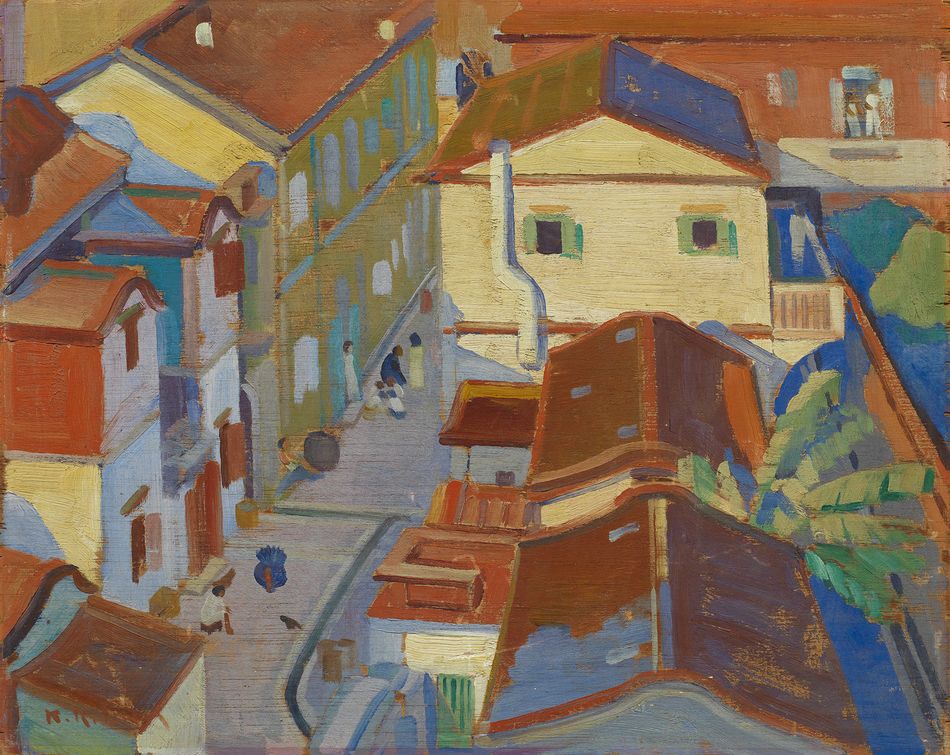Previous
Next






Estimate
Sold Price
Signature
Signed lower left K.K. Lim
Signed and titled reverse Alley by K.K.Lim
PROVENANCE
Pirvate collection, USA
Ravenel Auction, Taipei, June 1, 2014, lot 111
Acquired from the above by the present owner
Signed and titled reverse Alley by K.K.Lim
PROVENANCE
Pirvate collection, USA
Ravenel Auction, Taipei, June 1, 2014, lot 111
Acquired from the above by the present owner
+ OVERVIEW
Born in Banqiao, Taiwan in 1901. Lim was a descendant of the Lim Ben Yuan family, which was a respected family in Taiwan. As a senior painter of Taiwan, he was the only one who studied art in Europe before the 20th century and the first Chinese to become a member of the jury committee in the Sao Paulo Biennale . Due to his family background, he was influenced by both eastern and western culture and art from an early age. In 1920, he entered the University of Cambridge to study law and economics. In 1922, his artwork was selected to exhibit in the Royal Academy of Arts, England. After graduation, he began to study art and received his masters degree in western fine arts. In 1930, Lim returned from Europe to China, and then moved to Hong Kong due to war. Later, he moved back to Taiwan and spent his final years in the U.S.
Inspired by the relationship between nature and human life, Lim created works of realism or abstraction with his unique style. Lim was not only a brilliant painter but also an educator. He was a greatly recognized professor in fine arts for 18 years. His paintings “Nude” and “Beauty under the MoonLight” were selected in the 5th and 9th Taiwan Art Exhibition in 1931 and 1935. In 1991, Lim was awarded the “Achievement of Fine Arts” by the Executive Yuan's Council for Cultural Affairs. After he passed away, the Taipei Fine Arts Museum hosted “Exhibition of Lim Kac-keong” to commemorate his contribution to the development of Taiwan’s fine arts.
Lim Kac-keong had sketched the Taiwanese local landscapes for 20 years, and some common landscapes painted by the artist include Guanyin Mountain, Yehliu, Jiufen, and Taipei’s scenery viewed from Yangming Mountain. When drafting, he focused on simplicity: he would thoroughly observe the scenes and compose clear but meaningful drafts, which can be seen from his painting “Alley”. The organized lines portray the vanishing point, and the large color blocks bring out the overall sense of the picture. Lim inherited his coloring techniques from the European Impressionism movement. The light effects, with warmth in the lights and coldness in the shadows, and subtle changes in color are the most distinctive features of his artworks. On the streets, the people’s actions and the atmosphere add to the vividness of the artwork. Lim Kac-keong’s precise use of color allowed him to be praised by Hong Kong critics as “the landscape poet and the color musician”.
Inspired by the relationship between nature and human life, Lim created works of realism or abstraction with his unique style. Lim was not only a brilliant painter but also an educator. He was a greatly recognized professor in fine arts for 18 years. His paintings “Nude” and “Beauty under the MoonLight” were selected in the 5th and 9th Taiwan Art Exhibition in 1931 and 1935. In 1991, Lim was awarded the “Achievement of Fine Arts” by the Executive Yuan's Council for Cultural Affairs. After he passed away, the Taipei Fine Arts Museum hosted “Exhibition of Lim Kac-keong” to commemorate his contribution to the development of Taiwan’s fine arts.
Lim Kac-keong had sketched the Taiwanese local landscapes for 20 years, and some common landscapes painted by the artist include Guanyin Mountain, Yehliu, Jiufen, and Taipei’s scenery viewed from Yangming Mountain. When drafting, he focused on simplicity: he would thoroughly observe the scenes and compose clear but meaningful drafts, which can be seen from his painting “Alley”. The organized lines portray the vanishing point, and the large color blocks bring out the overall sense of the picture. Lim inherited his coloring techniques from the European Impressionism movement. The light effects, with warmth in the lights and coldness in the shadows, and subtle changes in color are the most distinctive features of his artworks. On the streets, the people’s actions and the atmosphere add to the vividness of the artwork. Lim Kac-keong’s precise use of color allowed him to be praised by Hong Kong critics as “the landscape poet and the color musician”.
Related Info
